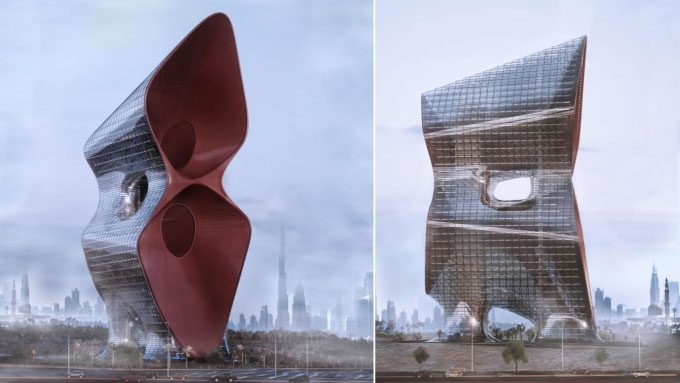The buildings in the project feature a primary structure consisting of two deep recesses designed to absorb sand particles, along with the installation of sand batteries for energy storage.
Kalbod Design, a studio based in Tehran (Iran), has introduced the Sandstorm Absorbing Skyscraper Project, aiming to harmoniously integrate the tropical desert climate of the UAE with architectural and urban development, as reported by Design Boom on March 14. Utilizing technology and creativity, the studio offers a sustainable architectural solution to the natural sandstorms occurring in Dubai.

Design of a sandstorm-resistant skyscraper. (Photo: Kalbod Design Studio).
One building alone is not sufficient to withstand sandstorms. Therefore, the project will consist of 25 buildings located along the main road of Dubai, facilitating mutual support. The building exteriors will be made of glass, while their designs will be inspired by their primary function – combating sandstorms.
Anyone who has visited Dubai or any other city in the UAE, especially during the spring and summer, may have experienced the tropical desert climate and significant sandstorms. When a sandstorm occurs, the normal pace of city life slows down or comes to a halt. Additionally, sandstorms gradually lead to respiratory issues, air and water pollution, adversely affecting the living environment.
Research shows that sand particles carry an electric charge. Therefore, the main structure of the buildings in this project will include two deep recesses designed to absorb sand particles magnetically, neutralizing their electric charges. Once trapped in the recesses, sand particles will adhere to smart panels inside. These panels will open to a certain extent depending on the intensity of the storm.
To ensure that all particles are neutralized, their entire electric charge will be absorbed in two different stages. Since the diameter of sand particles at lower altitudes is generally larger, the lower recesses will also have larger entrances. The design team also plans to install sand batteries within the buildings to store energy for several months, potentially providing power to other buildings in the area.
“Our ultimate goal is to create a multifunctional area focused on scientific research, with each tower serving a specific purpose. The division will include uses such as residential space and research institutes in physics, aerospace, technology, biology, and medicine,” the design team at Kalbod Design stated.


















































